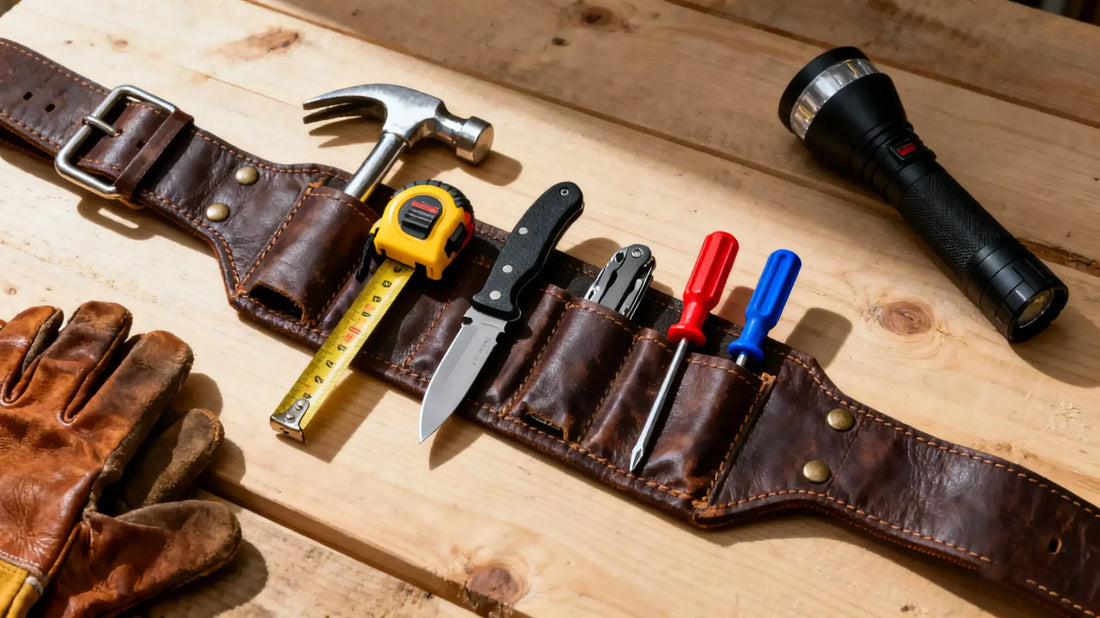
Mastering the Utility Belt: Powerful Tips for Everyday Carry
Share
Introduction
From construction sites to weekend adventures, the utility belt has become a symbol of efficiency and readiness. Originally designed for workers who needed constant access to tools, it has evolved into an essential accessory for tradesmen, outdoor enthusiasts, and even everyday carry (EDC) fans.
But mastering the utility belt isn’t as simple as strapping it on. The way you organize, wear, and maintain it will determine whether it becomes a true asset or just extra weight on your waist. In this guide, we’ll share powerful tips for everyday carry that will help you unlock the full potential of your utility belt.
Table of Contents
1.Choose the Right Utility Belt for Your Needs
2.Master the Art of Weight Distribution
3.Keep Tools Accessible and Organized
4.Avoid Overloading with Non-Essentials
5.Adjust Fit for Comfort and Efficiency
6.Customize with Modular Pouches
7.Adapt Your Setup for Different Scenarios
8.Maintain and Care for Your Utility Belt
9.Bonus Tips for Smarter Everyday Carry
10.FAQs About Utility Belts
11.Conclusion
1. Choose the Right Utility Belt for Your Needs
Not all utility belts are created equal. A construction worker, a carpenter, and a weekend hiker will all need different setups.
Work belts: Heavy-duty leather or nylon, designed for durability.
Tactical belts: Often MOLLE-compatible, perfect for outdoor or survival use.
Light EDC belts: Slimmer, versatile, suitable for casual carry.
2. Master the Art of Weight Distribution
A common mistake is letting all the heavy tools hang on one side. This leads to back pain and slower workflow.
Spread heavier tools (like hammers or drills) evenly.
Keep lighter tools (pens, markers, small knives) opposite for balance.
Use suspenders if carrying a heavy load for long hours.
3. Keep Tools Accessible and Organized
Every second counts when you’re on the job or in the field. Assign specific pouches for categories of tools:
Left side: fasteners, nails, screws.
Right side: hammer, tape measure, utility knife.
Front pockets: items you need most frequently.
Consistency builds muscle memory and speeds up your workflow.
4. Avoid Overloading with Non-Essentials
It’s tempting to carry everything, but overloading makes the utility belt bulky and uncomfortable. Focus on essentials:
A hammer, tape measure, knife, screwdriver, fasteners.
Leave bulky or rarely used tools in your toolbox or backpack.
5. Adjust Fit for Comfort and Efficiency
An ill-fitting belt is one of the fastest ways to burn out.
Ensure the belt sits snugly on the hips, not too high or too low.
Adjust tightness to prevent slipping.
Wear padded belts or suspenders for long days.
6. Customize with Modular Pouches
One of the biggest advantages of modern utility belts is modularity. Many belts now feature detachable pouches or MOLLE systems.
Add extra pouches for specialized projects.
Remove unneeded compartments for lightweight efficiency.
Switch setups quickly depending on the job.
7. Adapt Your Setup for Different Scenarios
A carpenter building cabinets, an electrician wiring a house, and a hiker on the trail all need different tools. Don’t stick to one setup.
Work setup: nails, hammer, screwdriver, pliers.
Adventure setup: flashlight, multi-tool, water bottle holder.
Everyday urban setup: phone case, wallet pouch, keys.
Go to view more configurations: Everyday Carry – EDC Community
8. Maintain and Care for Your Utility Belt
A poorly maintained belt will fail when you need it most.
Clean leather belts with conditioner to prevent cracking.
Wash nylon belts to remove dirt and sweat.
Regularly check stitching and buckles for wear.
Treat your belt as part of your tool kit — it needs care too.
9. Bonus Tips for Smarter Everyday Carry
Rotate items seasonally: lighter load in summer, heavier gear in winter.
Use color-coded pouches for quick identification.
Always test new setups at home before using them on the job.
FAQs About Utility Belts
Q1: Who uses utility belts today?
They’re used by carpenters, electricians, construction workers, outdoor enthusiasts, and EDC fans.
Q2: What’s the best material for a utility belt?
Leather for durability and strength, nylon for lightweight versatility.
Q3: Can a utility belt be used outside of work?
Yes — many hikers, campers, and everyday carry enthusiasts rely on them.
Q4: How do I prevent back pain when wearing a utility belt?
Balance weight properly and consider suspenders for extra support.
Q5: How long does a quality utility belt last?
With good care, 5–10 years depending on material and usage.
Conclusion
The utility belt is more than just a tool carrier — it’s a lifestyle accessory that blends practicality with preparedness. By following these powerful tips, you can streamline your everyday carry, reduce strain, and stay ready for whatever challenges come your way.
👉 Master your everyday carry with a utility belt built to last — because efficiency starts at your waist.
